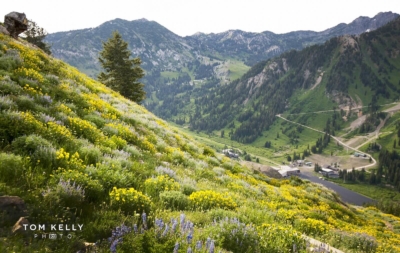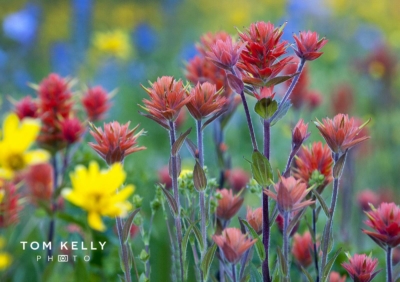Little Cottonwood Canyon Wildflower Hiking Guide
Tips for enjoying and capturing the Wildflowers at Alta and Snowbird
by Tom Kelly
With the heat of July, daydreams of chest deep powder coming off Alf’s High Rustler seem oh so distant. But the winter’s snowfall is doing its job as waves of colorful wildflowers are sprouting all across the hillsides in Little Cottonwood Canyon.
The entire Wasatch is alive with color this time of year. But nowhere is it more pronounced than on the mountain meadows surrounding Alta and Snowbird. All July and into August, wildflowers beckon hikers to the mountains – highlighted by the July 29-31 Wasatch Wildflower Festival.
If you haven’t been up Little Cottonwood Canyon lately, now’s the time. Here’s a guide to getting the most out of your wildflower adventure.
Where to Walk
Albion Basin | OK, it’s hard to beat the ease of access and seas of wildflowers that you find in Albion Basin. Make it easy and park in the lower lot, taking the family up the easy path through lower Albion Basin. Spots in the Catherine’s Pass lot up on the mountain go fast just after dawn, or you can ride the weekend shuttle.
Cardiff Pass | The south facing side of the canyon gets early snowmelt and is the first to bloom. Mid-July is perfect. It’s just a half mile to a sea of wildflowers from the trailhead by the town offices across from Alta Lodge. It’s a bit steepish but an easy trail offering panoramic views from Alta all the way east to the Pfeifferhorn. You can continue on up past the wildflowers to Cardiff Pass, or make it an epic summit day by heading up to Monte Cristo and Mt. Superior. I like the great diversity of flowers and almost no people.
 Grizzly Gulch | Instead of taking the right fork to Cardiff Pass, head right up Michigan City Road and into Grizzly Gulch and on up to Twin Lakes Pass for spectacular views. You’ll experience great wildflowers and a host of old mines. If you want a longer hike, you can extend your adventure into Big Cottonwood Canyon to Twin Lakes, over to Lakes Mary and Catherine then up and over Catherine’s Pass and down into Albion Basin.
Grizzly Gulch | Instead of taking the right fork to Cardiff Pass, head right up Michigan City Road and into Grizzly Gulch and on up to Twin Lakes Pass for spectacular views. You’ll experience great wildflowers and a host of old mines. If you want a longer hike, you can extend your adventure into Big Cottonwood Canyon to Twin Lakes, over to Lakes Mary and Catherine then up and over Catherine’s Pass and down into Albion Basin.
Mineral Basin | Snowbird is ablaze in color, but the richest veins are in Mineral Basin. Take the tram to the top and hike in. You’ll be greeted by a rainbow of color. Loop your way through Mineral Basin to the tunnel, where you can visit a display of 19th century mining artifacts before riding the Peruvian chair lift back down.
5 Tips for Photographing Wildflowers
Wildflowers in Little Cottonwood are a photographer’s paradise with reds, yellows, blues, whites and more. To help you convert what your eye sees into a cherished memory of a photograph, here are a few tips. And don’t worry if you aren’t using the latest Nikon or Sony – even your simple iPhone will do.
- Learn the Light | Your eye has the ability to process many different light levels at once. Your digital camera is a bit more limited. Look at your scene and strive to have even light levels across the frame. Avoid harsh sunlight and dark shade in the same image.
- Brightness of Flowers | The color in wildflowers is intense! And while it may look stunning to your eye in bright sunlight, the camera doesn’t always see it that way. The pros know that wildflowers in shaded light render the most detail. Flowers in bright sunlight tend to wash out the details with the brightness. Watch that carefully!
- Rule of Thirds | One of the best composition tips you follow is the rule of thirds. In your mind, draw two vertical and two horizontal lines across your frame. The four intersection points are the most valuable content areas. Look to place key elements of your photograph into thirds – not halves – in your frame.
 Foreground Flowers | If you watch the pros working Albion Basin at sunrise, they’re looking for images with shaded wildflowers in the foreground and alpine peaks in the background. The killer moment is when the first light bathes the rim of Devil’s Castle. It’s good balanced light with pronounced color of the wildflowers with the first hint of daybreak on the mountains. Use a wide angle lens and a tripod.
Foreground Flowers | If you watch the pros working Albion Basin at sunrise, they’re looking for images with shaded wildflowers in the foreground and alpine peaks in the background. The killer moment is when the first light bathes the rim of Devil’s Castle. It’s good balanced light with pronounced color of the wildflowers with the first hint of daybreak on the mountains. Use a wide angle lens and a tripod.- Closeups | Take a hike up Cardiff Pass or into Mineral Basin and see how many different wildflowers you can photograph. Get in there close, filling your frame with a single wildflower. A macro or micro lens is nice for closeups. But any mid-focal length lens will do. Try for shaded flowers to record the best detail.
A walk through the wildflowers in Little Cottonwood Canyon is a real treat. The best time is July and August. South facing slopes will bloom first and fade first. North facing slopes, like much of Albion Basin, will last longer.
While out there, be good stewards of the land. Leave the flowers there for others to share. Little Cottonwood Canyon is a water shed so, no dogs, please. Make sure to bring plenty of water.
I look forward to seeing you on the trail!
In honor of Wildflower Season in Little Cottonwood Canyon Canyon Services has great lodging specials – check them out here and get the most out of this beautiful time of year in the mountains!
Online Resources
About the Author, Tom Kelly
Photographer Tom Kelly is a Wisconsin native who moved to the Wasatch in 1988. A former award-winning news photographer, he now finds his way to the wildflower covered slopes of Utah’s mountains to record stunning landscapes. You can see his work at the Artique gallery in Kamas, Utah, on Instagram @TomKellyPhoto.
